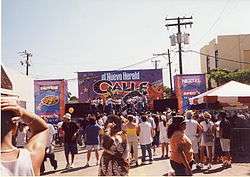Calle Ocho Festival

The Calle Ocho Festival (La Festival de la Calle Ocho) is a one-day fiesta that culminates the Miami Carnival. It takes place in March in the Little Havana neighborhood of Miami, Florida between SW 8th Street and 27th Avenue.[1]
The festival is one of the largest in the world, and over one million visitors attend the Calle Ocho event. It is a free street festival that showcases Pan-American culture. It is one of many best festivals in the world. [2][3]
History
Calle Ocho started in 1978 as a way for Cuban immigrants to express themself and teach about their culture in the community.[4][5] The festival's focus grew to include participation from all Latin American countries[6]
In 1996, the festival was cancelled due to the shooting down of four Cuban exile aviators by Cuban warplanes on February 24, 1996. The aviators were part of the Brothers to the Rescue organization.[7]
Program
The annual festival shuts down 24 blocks of SW 8th Street in order to host dancing, food, drink and 30 stages of live entertainment.[8]
The stages are spread throughout Little Havana, and host various styles of Latin music from the Hispanic countries and the Caribbean,[9] from merengue to top 40 pop music.
Carnaval Miami is organized and sponsored by the Kiwanis Club service organization of Little Havana.[10]
Recognitions
In 1988, the festival set the Guinness World Record with 119,986 people in the world's longest conga line.[11]
In 1990, a world-record-breaking 10,000-pound piñata was featured.[12]
In 2000, the Guinness World Record was set for the world's longest cigar.
In 2008, Calle Ocho broke the record for the most domino players at the event.
In 2010, the Florida legislature identified the Calle Ocho-Open House 8 festival as the official state festival.[13]
In 2012, the festival broke the world record for the largest flag image ever created. The flag measured 250 feet long and 36 feet wide, and was marched down the street by over 100 volunteers[14]
References
- ↑ "Calle Ocho Festival and Carnaval Miami 2015". Miami All Around.
- ↑ Super User. "CALLE OCHO". carnavalmiami.com.
- ↑ Jan Lin (22 September 2011). The Power of Urban Ethnic Places: Cultural Heritage and Community Life. Routledge. pp. 120–. ISBN 978-1-136-90985-6.
- ↑ Michael Benson (2000). Gloria Estefan. Twenty-First Century Books. pp. 43–. ISBN 978-0-8225-4982-6.
- ↑ "Calle Ocho-Miami Carnival". americaslibrary.gov.
- ↑ "Calle Ocho - Miami Calle Ocho festival - El Festival de la Calle Ocho". holamiami.com.
- ↑ http://www.education.miami.edu/ep/littlehavana/Street_Festival/Hackley_1/Hackley_2/hackley_2.html
- ↑ Antonio Jorge; Jaime Suchlicki; Adolfo Leyva de Varona (1 January 1991). Cuban Exiles in Florida: Their Presence and Contributions. Transaction Publishers. pp. 27–. ISBN 978-1-4128-4490-1.
- ↑ "Another successful Calle Ocho in the books". Liane Morejon, reporter, Loccal10.
- ↑ "Calle Ocho Festival & Carnaval - MiamiandBeaches.com". miamiandbeaches.com. Archived from the original on 2014-11-25.
- ↑ Ronald H. Bayor (31 July 2011). Multicultural America: An Encyclopedia of the Newest Americans. ABC-CLIO. pp. 438–. ISBN 978-0-313-35786-2.
- ↑ "Calle Ocho Carnival, March 15, 2015 - HomeAway Travel Ideas". homeaway.com.
- ↑ "Chapter 15 - 2010 Florida Statutes - The Florida Senate". flsenate.gov.
- ↑ "Calle Ocho Breaks World Record In Miami For Largest Flag Image Ever Created (PHOTOS)". The Huffington Post.